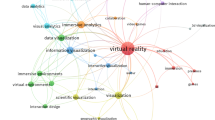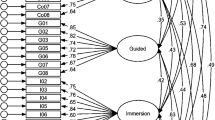Abstract
Through years of development Content Networks (CN) have become more sophisticated and more technically diverse. Modern CN are designed to be more adaptive to communication environment, devices and user requirements. However, one open issue is the still fluctuating quality of service provision. As a result user experience can be negatively affected. In order to maintain a satisfactory level of user experience it is crucial to develop a feasible solution to measure the extent to which video services meet users’ expectation. Assessing video quality with respect to users’ subjective opinions is a complex task. In this paper we address challenges of this task and design an integrated framework using a number of comprehensive functional modules. Our framework integrates objective quality assessment models of Artifacts Measurement (AM) and Quality of Delivery (QoD) approaches. Only the fittest models are activated by the framework considering requirements of individual evaluation tasks. We also introduce our recent work of realising key functional modules of the framework. Joint subjective experiments between two institutes have also been carried out for the purpose of model implementation and evaluation. Results from experiments verify the concept of an integrated framework and show the effectiveness of its key modules in estimating the quality level of video services.















Similar content being viewed by others
Notes
In the presented research the scale has 11 values but some different scales are possible, too.
References
Addis B, Leyffer S (2006) A trust-region algorithm for global optimization. Comput Optim Appl 35(3):287–304. doi:10.1007/s10589-006-8716-2
Botta A, Pescape A (2011) Ip packet interleaving: bridging the gap between theory and practice. In: Proc. IEEE symp. computers and communications (ISCC), pp 1022–1029. doi:10.1109/ISCC.2011.5983976
Botta A, Pescapè A, Ventre G (2008) Quality of service statistics over heterogeneous networks: analysis and applications. Elesevier EJOR
Brand ando T, Queluz M (2010) No-reference quality assessment of h.264/avc encoded video. IEEE Trans Circuits Syst Video Technol 20(11):1437–1447. doi:10.1109/TCSVT.2010.2077474
Chan A, Zeng K, Mohapatra P, Lee SJ, Banerjee S (2010) Metrics for evaluating video streaming quality in lossy ieee 802.11 wireless networks. In: Proceedings of the 29th conference on information communications, INFOCOM’10. IEEE Press, Piscataway, NJ, pp 1613–1621. http://portal.acm.org/citation.cfm?id=1833515.1833741
Claypool M, Zhu Y (2003) Using interleaving to ameliorate the effects of packet loss in a video stream. In: Proc. 23rd int distributed computing systems workshops conf, pp 508–513. doi:10.1109/ICDCSW.2003.1203604
CMP Media LLC (2009) Measuring IPTV QoS performance at the box. http://www.digitaltvdesignline.com/
Dosselmann R, Yang XD (2007) A prototype no-reference video quality system. In: Fourth Canadian conference on computer and robot vision, CRV ’07, vol 2007, pp 411–417
Eskicioglu AM (2000) Quality measurement for monochrome compressed images in the past 25 years. In: Proceedings of the international conference on acoustics, speech and signal processing (ICASSP). IEEE, Istanbul, Turkey, pp 1907–1910
Eskicioglu AM, Fisher PS (1995) Image quality measures and their performance. IEEE Trans Commun 43(12):2959–2965
Farias MCQ, Mitra SK (2005) No-reference video quality metric based on artifact measurements. In: IEEE international conference on image processing, ICIP 2005, vol 3, pp III–141–4
Fukumoto K (2004) Taking bounded variables seriously: extended beta binomial, asymmetric logit, and time series. In: Research workshop in applied statistics
Geerts D, De Moor K, Ketyko I, Jacobs A, Van den Bergh J, Joseph W, Martens L, De Marez L (2010) Linking an integrated framework with appropriate methods for measuring qoe. In: Second international workshop on quality of multimedia experience (QoMEX)
ITU-R (1998) ITU-R BT.1129 subjective assessment of standard definition digital television (SDTV) systems. ITU-R
ITU-R (1998) ITU-R BT.500 methodology for the subjective assessment of the quality of television pictures, Geneva, Switzerland
ITU-T (1996) ITU-T P.800 methods for subjective determination of transmission quality. ITU-T, Geneva, Switzerland
ITU-T (1999) ITU-T P.910 subjective video quality assessment methods for multimedia applications. ITU-T
Jain R (2004) Quality of experience. IEEE Multimed 11(1):96–95
Kangasharju J, Mu M, Colussi GD (2008) Application-level fairness. In: Proc. international conference on information networking 2008 (ICOIN 2008), Busan, Korea
Kwon JC, Jang SH, Chin Y, Oh SJ (2010) A novel video quality impairment monitoring scheme over an ipty service with packet loss. In: 2010 second international workshop on quality of multimedia experience (QoMEX), pp 224–229. doi:10.1109/QOMEX.2010.5516127
Lee J, Hoppel K (1989) Noise modeling and estimation of remotely-sensed images. In: Proc. international geoscience and remote sensing, Vancouver, Canada, vol 2, pp 1005–1008
Liang YJ, Apostolopoulos JG, Girod B (2003) Analysis of packet loss for compressed video: does burst-length matter? In: Proc. IEEE int. conf. acoustics, speech, and signal processing (ICASSP ’03), vol 5. doi:10.1109/ICASSP.2003.1200063
Liu T, Wang Y, Boyce JM, Yang H, Wu Z (2009) A novel video quality metric for low bit-rate video considering both coding and packet-loss artifacts. IEEE J Select Top Signal Process 3(2):280–293. doi:10.1109/JSTSP.2009.2015069
MSU Graphics & Media Lab (Video Group) (2009) MSU video quality measurement tool. http://compression.ru/video/quality_measure/video_measurement_tool_en.html/
Mu M, Mauthe A, Garcia F (2008) A utility-based qos model for emerging multimedia applications. In: Proc. first IEEE future multimedia networking (FMN 08) workshop, Cardiff, UK
Mu M, Gostner R, Mauthe A, Garcia F, Tyson G (2009) Visibility of individual packet loss on h.264 encoded video stream—a user study on the impact of packet loss on perceived video quality. In: Proc. sixteenth annual multimedia computing and networking (MMCN’09), San Jose, California, USA
Mu M, Mauthe A, Haley R, Garcia F (2011) Discrete quality assessment in IPTV content distribution networks. Signal Process Image Commun 26(7):339–357, Advances in IPTV Technologies, Elsevier
Ohm J-R (1999) Bildsignalverarbeitung für Multimedia-Systeme, Berlin
OPTICOM (2007) Perceptual evaluation of video quality. http://www.opticom.de/technology/pevq.html
Pinson M, Wolf S, Gallagher M (2004) The impact of monitor resolution and type on subjective video quality testing
van den Branden Lambrecht CJ, Verscheure O (1996) Perceptual quality measure using a spatio-temporal model of the human visual system. In: Proc. SPIE, vol 2668, pp 450–461
VQEG (2004) Index VQEG test sequences. ftp://vqeg.its.bldrdoc.gov/SDTV/VQEG_PhaseI/TestSequences/
VQEG (2008) Final report from the video quality experts group on the validation of objective models of multimedia quality assessment, phase I. ftp://vqeg.its.bldrdoc.gov/Documents/Projects/multimedia/MM_Final_Report/VQEG_Multimedia_PhaseI_Final_Report.zip
VQEG (2008) Final report from the video quality experts group on the validation of objective models of video quality assessment, phase II. VQEG final report of FR-TV phase II validation test
VQEG (2009) The video quality experts group. http://www.vqeg.org/
Wang Y (2006) Survey of objective video quality measurements. EMC Corporation Hopkinton. ftp://ftp.cs.wpi.edu/pub/techreports/pdf/06-02.pdf
Wang Z (1998) Objective image/video quality measurement—a literature survey. In: EE 381k: multidimensional digital signal processing
Wang Z, Lu L, Bovik AC (2004) Video quality assessment based on structural distortion measurement. Signal Process Image Commun 19(2):121–213
Winkler S (1999) A perceptual distortion metric for digital color video. In: Proc. SPIE, vol 3644, pp 175–184
Winkler S (2005) Digital video quality—vision models and metrics. John Wiley & Sons, Ltd
Winkler S (2007) Video quality and beyond. In: Proc. European signal processing conference, Poznan, Poland
Wolf S, Pinson MH (1999) Spatial-temporal distortion metrics for in-service quality monitoring of any digital video system. In: Proc. SPIE, vol 3845, pp 266–277
Yang F, Wan S, Xie Q, Wu HR (2010) No-reference quality assessment for networked video via primary analysis of bit stream. IEEE Trans Circuits Syst Video Technol 20(11):1544–1554. doi:10.1109/TCSVT.2010.2087433
Yim C, Bovik AC (2011) Evaluation of temporal variation of video quality in packet loss networks. Signal Process Image Commun 26(1):24–38. doi:10.1016/j.image.2010.11.002. http://www.sciencedirect.com/science/article/B6V08-51FGSXF-1/2/b8af320f14b4e2c56a73dcb4ff042ca1
Acknowledgements
Application of Piotr Romaniak’s, Mikolaj Leszczuk’s and Lucjan Janowski’s research leading to these results has received funding from the European Community’s Seventh Framework Program (FP7/2007-2013) under grant agreement n°218086 (INDECT). Mu Mu’s work is also supported by Agilent Laboratories UK, European Commission within the FP7 Project: P2P-Next and Framework for Innovation and Research in MediaCityUK (FIRM). Eduardo Cerqueira was supported by The National Council for Scientific and Technological Development (CNPq—Brazil) and Fundacao de Amparo a Pesquisa do Estado do Para (FAPESPA). The authors thank Piotr Borkowski from AGH University of Science and Technology, Roswitha Gostner from Lancaster University and Francisco Garcia from Agilent Laboratories for their input.
Author information
Authors and Affiliations
Corresponding author
Rights and permissions
About this article
Cite this article
Mu, M., Romaniak, P., Mauthe, A. et al. Framework for the integrated video quality assessment. Multimed Tools Appl 61, 787–817 (2012). https://doi.org/10.1007/s11042-011-0946-3
Published:
Issue Date:
DOI: https://doi.org/10.1007/s11042-011-0946-3




